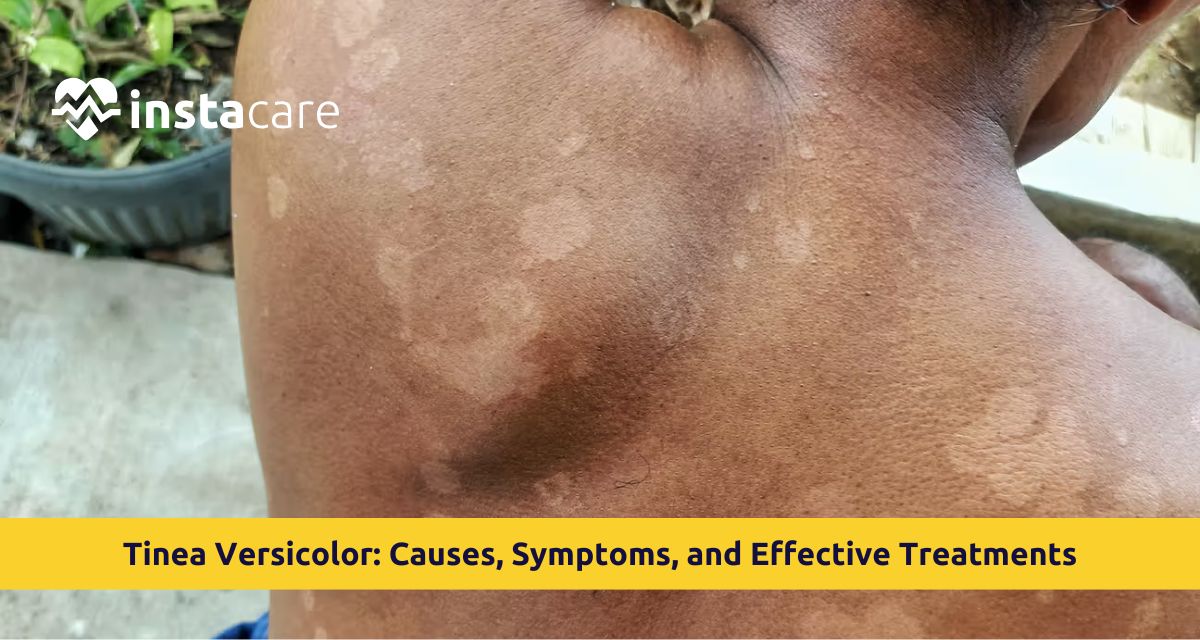What is Tinea Versicolor?
Tinea versicolor or pityriasis versicolor refers to Malassezia yeast infection of human skin by being a normal resident of human skin. The fungus multiplies abnormally under certain conditions on darker or lighter areas of epidermis than the rest.
Tinea versicolor in summer is more prevalent, hot climate, and oily or sweat-inducing individuals. Facial, neck, back, and chest tinea versicolor does not cause any pain to one, but cosmetic alterations occur that most individuals would desire to eliminate early.
Tinea Versicolor Causes
There are various factors that predispose one to excessive Malassezia yeast. Tinea versicolor causes tend to be lifestyle and environmental and include:
- Hot and humid climate (most prevalent in hot or tropical weather)
- Excessive perspiration
- Oily skin
- Immunocompromised status
- Hormonal changes, e.g., puberty
- Wearing tight clothing, which prevents skin from being able to sweat out moisture and heat from the body
As yeast already resides on the body, tinea versicolor is not contagious itself. There are some medical conditions, however, that will interfere with the natural balance of the skin, causing the yeast to become activated.
Tinea Versicolor Symptoms
The most typical sign of tinea versicolor is that flat-colored patches will form on your skin. Patches also can change their color relative to your own color as well as with the pigmentary effect of the fungus.
Typical signs and tinea versicolor symptoms are:
- Pink, red, brown, tan, or white spots on the skin
- Itching of the wet skin
- Dry, scaly surface of the affected skin
- Areas that become more apparent after sun exposure
- Light peeling or shedding of the skin
The most common skin condition is usually tinea versicolor on face, neck, shoulders, chest, back, and can also be seen on other areas of the body. Keep in mind, discoloration will be apparent a few weeks or even months prior to your normal color return. It is not a sign that the infection still exists.
Tinea Versicolor Diagnosis
If you believe that you have tinea versicolor, then it is the tinea versicolor that the dermatologist might be getting to diagnose. Physicians typically do tinea versicolor diagnosis by:
- Physical examination of the rash
- Woods lamp test (ultraviolet light which will become yellow-green color of patches)
- Microscopic skin scrape on microscopic examination
- Skin biopsy in the extremely rare case
You can treat and diagnose early in order to rule out other such-appearing conditions such as vitiligo, resulting in depigmentation in a different way.
Tinea Versicolor and Vitiligo: What's the Difference?
Both tinea versicolor vs vitiligo are easy to mistake since both result in patches of light color. They differ, however:
- Tinea versicolor is caused by the fungus overgrowth whereas vitiligo is an autoimmune condition killing pigment-carrying cells.
- They are non-pruritic but whereas the former are scaly pruritic lesions, the latter is smooth and not pruritic.
- Tinea occurs on the upper arm and back whereas vitiligo occurs on hands, face, and orifices of the body.
- They can both be diagnosed through examination or test by a dermatologist either way.
Luckily, tinea versicolor is simple to cure and overcome. It is cured with whatever they prefer to put on, ranging from antifungal over-the-counter creams to oral treatment for tinea versicolor based on how often and how badly the condition occurs.
1. Topical Antifungals Creams
Antifungal creams for tinea versicolor will likely be the initial treatment for less severe cases. They include:
- Clotrimazole
- Miconazole
- Ketoconazole
- Terbinafine
The creams destroy the fungus and inhibit further growth. They are applied once or alternate days for 1–2 weeks.
2. Antifungal Shampoos
Tinea versicolor shampoo is routine too in treatment. Affected skin sites (not just scalp) are shampooed using shampoos with selenium sulfide, zinc pyrithione, or ketoconazole. They are applied in the presence of extensive lesions or over the back and chest.
3. Oral Antifungal Agents
In chronic or recurrent tinea versicolor, doctors employ oral therapy of tinea versicolor as:
They are systemic and are employed mainly where the use of topical therapy is not possible or ineffective.
Home Remedies and Homeopathic Treatment for Tinea Versicolor
Home remedy and homeopathy for tinea versicolor are practiced by others as aftercare or as minimal treatment. Though remedies are not as efficient as medicine, they apparently can regulate symptoms or recurrences.
Natural Remedy is Not Rare
- Tea tree oil: Anti-inflammatory and antifungal.
- Coconut oil: Fungicides of great importance.
- Apple cider vinegar: Acidity induces normalization of pH of the skin and inhibits growth of fungi.
- Aloe vera: Moisturizes skin and possesses weak antifungal activity.
Tinea versicolor natural treatment must be used with care and removed in case of irritation being caused. They must be administered as adjuncts to, and not substitutes for, evidence-based treatment.
Tinea Versicolor and Sun Exposure
Sunlight will never induce the infection, but will induce the spots to appear, and they will become darker. Ordinary skin tans as ordinary skin. Infected skin will not tan, and therefore pigmentation is accentuated. Shun tanning or prolonged sun exposure with an outbreak. Use sunscreen on the skin at all times, and loose, light clothing to avoid sweating.
How to Rid Yourself of Tinea Versicolor and Prevent it from Recurring
Not only how to rid yourself of the current infection, but also how to prevent it from recurring.
This is what to do as a precaution to try and minimize risk of recurrence:
- Shower following perspiration
- Shampoo hair with antifungal weekly or fortnightly during summer season as a preventive measure
- Use loose clothes or natural fibers
- Practice proper hygiene
- Apply antifungal soaps having medicinal properties
Recurrent tinea versicolor is common, especially in warm climates. Talk to your doctor about maintenance therapies if you’re prone to frequent flare-ups.
Final Thoughts
Tinea versicolor is an infectious but all-too-common infection of the skin. Although not of a serious health type, tinea versicolor is ego-shattering and life-affecting to one's ego and lifestyle, especially if the infection is located on the face, neck, or chest.
Because of the variety of treatments for tinea versicolor, such as topical therapy and systemic antifungals, as well as soothing tinea versicolor home remedies, in the overwhelming majority of instances patients are able to successfully manage the infection and restore control.
Educate yourself as to why tinea versicolor happens and stay away from such offenders as the sun or hot showers may be your key. If you have had recurrent or chronic tinea versicolor, do not be afraid to go to a dermatologist for an individualized regime that will work for your lifestyle and skin.
Please book an appointment with the
best Dermatologist in Lahore, Karachi, Islamabad, and all major cities of Pakistan through
InstaCare, or call our helpline at 03171777509 to find the verified doctor for your disease.

